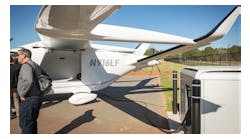Whether managing a relatively new or a much older pavement network, every airport has to design and construct airfield pavement projects at some time. Architecture and engineering firm HDR has assisted many airports through these projects and HDR aviation experts Sagar Bethu and Tim Ward shared the insights they’ve gained over the years. Bethu (Maryland/Virginia) and Ward (Pennsylvania/Ohio/West Virginia) serve as regional aviation leads for HDR and both also serve on the American Society of Civil Engineers’ Airfield Pavement Committee.
Most airfield pavement projects can be broken down into one of four broad classifications:
- Repairs, including crack and joint sealing, localized patching, concrete spall repairs;
- Rehabilitation, such as surface treatments, resurfacing, structural overlay (asphalt pavement), concrete pavement restoration and diamond grinding (concrete pavement);
- Reconstruction of severely distressed pavement or to meet increased capacity needs;
- New construction, such as expansions or widenings.
A typical project goes through the following stages: Planning, budgeting, information gathering (as-builts, survey, engineering data collection), alternatives analysis, preferred alternative design, procurement, construction.
Clear expectations are important. When starting a project, Ward said an airport should have adequate information on the current and future capacity needs for the pavement, as well as traffic forecasts and the project’s desired service life. Knowing stakeholder needs and anticipated funding sources and timing are also important.
“Airports also need to be aware of the anticipated impacts to their airfield operations during construction. Having a pulse on these factors will enable the airport to plan ahead and have realistic expectations on the timing of design and construction,” Bethu added.
For a successful pavement design project, Bethu said an airport and its partners also need good information and communication. This includes as-built construction data and maintenance history, construction budget, traffic data, stakeholder expectations and any restrictions on airfield access and construction operations.
“Proactive collaboration and communication with the airport staff throughout the project life-cycle will help in mitigating project risks and a prompt resolution of problems, if and when they occur,” Bethu added.
A lack of accurate as-built construction data, traffic data and subsurface utility data are some of the common challenges that Ward said airports encounter during the design phase.
“These gaps can be filled by supplementing the design scope with adequate geotechnical investigation, subsurface utility engineering (SUE) survey, and interviews and coordination with appropriate airport staff,” Ward said.
Other challenges occur during the construction stage, including limited time and space available for construction, long lead construction items and unfavorable weather.
To help pavement last, Bethu said it helps to think of it like any other critical asset.
“This means being proactive in budgeting for pavement improvements. Having a 10- to 20-year long term vision for the airport pavements can eliminate or reduce the backlog of major rehabilitations,” Bethu said.
A key to this is preventive maintenance, which Ward said can make sense to include at a program level.
“Where possible, owners can consider funding an exclusive preventive pavement maintenance program, where a dedicated amount of funding is allocated to preserve and maintain existing pavement assets to extend their service life and delay the timing and need for major rehabilitation. When owners start considering pavement maintenance plans for specific areas that have foreign object debris problems, it’s often too late to implement a cost effective repair plan that will significantly extend the service life of the pavement,” Ward added.
On new construction or reconstruction, designs should account for improvements like edge drains and subgrade stabilization. Local conditions and required pavement smoothness will also dictate customized designs. And a robust QA/QC process during construction is imperative.
“Subgrade preparation, compaction, subsurface drainage, and smoothness are all critical during the time of initial construction and will pay rich dividends throughout the pavement life,” Bethu said. “Focus on preventing problems bottom-up. Then repairs are only typically needed within the surface layers and they tend to be less expensive and disruptive to operations.”




